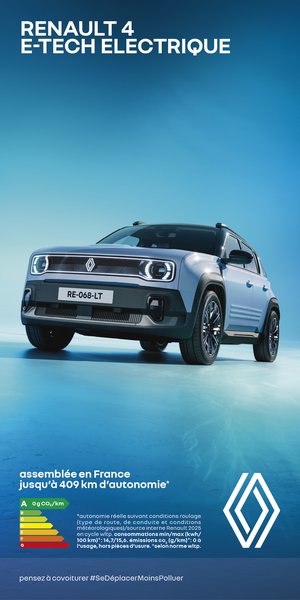
Politique Internationale — Is there a special relationship between the French and their cars?
Jean Viard — If you listen to some people, we’re a country that’s turned its back on the automobile. That’s a comment from a Parisian, or from people who only take their cars on vacation. In reality, we still see just as many cars all around us. How could it be otherwise? Some 63% of French people live in a house with a garden. Until we have proof to the contrary, this type of home is not located along an RER line. The majority of our compatriots live in suburban areas. They need a car to get around, especially to go to work. The Gilets jaunes protest against fuel prices has served as a reminder of this need for cars. This population is often criticized for driving “stinking diesel”. That’s forgetting that they only have access to second-hand cars, often two per household – in this case one for the husband and one for the wife, bearing in mind that the wife often gets her husband’s pre-owned car, a second-hand second-hand as it were.
P. I. — And yet it seems as if the car is less pervasive in people’s minds...
J. V. — Of course, when you live downtown, you’re less likely to spontaneously talk about cars. The same is true when you do a minimum of telecommuting.
It’s also a generation issue. There was a time, a long time ago now, when getting a driver’s license meant absolute freedom.
In fact, you could get one at the age of 18, whereas you had to wait until 21 to get the right to vote! In short, the automobile seemed a little like El Dorado. Today, things are different: the rising generation often waits until their thirties to take off, in every sense of the word. Parents are expecting their first child around the age of 31: the arrival of a baby is a milestone on the road to the automobile; the family will need a vehicle to get around. Still with this family in mind, it’s a shame that almost all models don’t have enough space to fit more than two child seats in the back.
P. I. — Is this relationship with the automobile the same everywhere else?
J. V. — Each country has its own specific characteristics. The Germans, for example, have a cult of the big car. They put all the more money into buying a car because rents are so low in Germany. In countries where real estate is cheap, people invest more in mobility. In Germany, there’s also the weight of the war, with its avalanche of destruction: when people know they could lose their home, they prefer to buy something else.
The United States is in a class of its own: it’s the country par excellence of mobility, in the wake of wagons, conquests, new lands to settle in, History with a capital “H”. Americans are not afraid to move: they prove it on a daily basis, with citizens ready to relocate almost overnight when professional circumstances demand it. The same Americans, taking all modes of transport into account, travel an average of 80 kilometers a day. The French are at 70 kilometers, compared with 5 kilometers fifty years ago. Admittedly, the United States is much larger than France, but there are explanations for this small gap: in France, there are still areas that are poorly connected to transport networks, despite high population density. Bouches-du-Rhône is a case in point: Marseille and Aix-en-Provence belong to the same conurbation, yet two regional trains can’t pass each other, as two RERs can in the Paris region; between Aix and Marseille, the tracks are used successively in one direction or the other. In such conditions, residents immediately choose to take the car.
And let’s not forget even more specific countries: Denmark, for example, where 30% of all journeys are made by bicycle – a tradition that dates back to the 19th century and is deeply rooted in people’s behavior. In Copenhagen, there’s no need to tie up your bike, you’re sure to find it again – something that would be unthinkable in France.
P. I. — Speaking of bicycles, many observers are calling for multimodality. What are your thoughts on this?
J. V. — It all depends on where you live. Of course, it can happen that you use one form of transport after another. The typical example is the person who takes his or her bike or car to the station and, on getting off the train or RER, catches a bus to get to work. This combination may seem efficient, but it is singularly time-consuming. What’s more, it presupposes a sufficiently dense transport network, with adequate facilities and regular timetables. Which is not always the case, far from it.
P. I. — The electric car is now burgeoning. What do you think of this rise?
J. V. — I think we’re only at the beginning of the process. Let me explain: at the moment, the electric vehicle is primarily associated with large models, SUVs that don’t say they’re SUVs; those afforded by corporate fleets, which are fond of the brand image conveyed by electric vehicles. These models, by definition, are heavy, and therefore not very well suited to being handled in many parking lots. There’s also the question of price: for the moment, the Chinese industry is the only one able to offer electric cars at prices starting from 25,000 euros, a starting price for small models, the niche in which Europeans will have to develop to take market share. Incidentally, 25,000 euros is still a very high price for most households. Finally, people are still wondering whether there are enough charging stations throughout the country. When you list all these points, you can see just how much effort is required of the electric sector to change people’s minds. Let’s just say that the foundations have been laid, and now it’s up to us to remove each and every one of these obstacles. This won’t happen overnight.
P. I. — Electric cars are turning their backs on fossil fuels, which have become an expensive energy source. But, as you said, they are also expensive vehicles. To what extent should public authorities subsidize electric cars? Is this a public service mission?
J. V. — These are eminently political issues, which are often multi-faceted. Further proof is provided by plans to tax electricity consumption. If this were to materialize, it would negate the whole communication policy of the electric car, i.e. a mode of transport that can ignore the price curve of fossil fuels. Subsidies? There are levers on which we can act much more easily. Do you know that 40% of vehicles currently on the road are service vehicles, whether they’re cabs, goods and/or food transporters, or government-owned? And yet, not only do most of them run on diesel, they have also been granted dispensations to remain on diesel. This decision – the fruit of intense lobbying – makes no sense at a time when global warming is a major concern. The interested parties claim that it’s too expensive to replace diesel with electric. That’s not true. They’re not like households: they don’t buy their cars from a catalog, but can instead benefit from particularly attractive pricing conditions.
P. I. — The fight against global warming: no one disputes that the development of electric cars is a major counter to CO2 emissions. But are consumers aware of the benefits? When they buy a car, is ecological urgency part of their thinking?
J. V. — Yes, consumers know how to be virtuous. Mind you, this is a relatively recent phenomenon, nor is it set in stone. Nevertheless, the trend is clear. In this respect, the pandemic amplified the situation. Humanity has become more aware than ever of the signs of its fragility. The notion emerged that we had to react, and not just against the risks of certain viruses spreading. The imperatives of carbon control can no longer be ignored. However, ecology has not yet won the battle of ideas. On the political front, to take France as an example, the ecological camp suffers from being assimilated into the left. This considerably hampers its ability to broaden its audience among different sections of the population.
P. I. — You might say that the rise of the electric car and sustainable mobility in general is capable of transcending all divisions...
J. V. — The debates have become all the more complex as two kinds of rupture have occurred. The first is that it is now nature that makes history, rather than the other way round. Man no longer has control over a large number of issues, even if he tends to forget it. The second break is of a completely different kind, but no less important: the relationship between men and women has changed profoundly. The male supremacy that reigned for centuries is in retreat. The automotive sector is no exception to this trend, in the sense that the car is no longer as sexualized an object as it once was.
P. I. — We’ve mentioned the power of Chinese industry when it comes to electrics. How can we encourage consumers to buy domestically?
J. V. — Price is the first indicator people spontaneously turn to. They have a budget for a car, and that budget can’t be stretched. As proof of this, the vast majority of French people buy used cars. I’m not even going to mention speed: that was a thing of the past. With a speed limit of 130 kilometers, consumers are no longer interested in a speedometer that reads 200, 220 or 240 km/h. As for national preferences, one example leaves me wondering: I often travel to attend or take part in meetings where leading experts and managers in various fields speak. During their speeches, they like to talk about industry, infrastructure, innovation and how to anchor these tools and know-how at the heart of the regions. However, when you leave the parking lot, you’ll notice that a good number of them drive Japanese cars.
P. I. — Is electric power the first step in a far-reaching revolution that could take us all the way to the autonomous vehicle?
J. V. — For the time being, the autonomous vehicle is above all something to dream about, prompting technological speculation. However, its place in society is already worth studying: in particular, this model could be used for the over-80s, an age group that is often advised to stop driving even though it needs to get around. Incidentally, I’ve noticed that every time an elderly person causes an accident, there’s an outcry. Not that this is totally unjustified, especially in certain cases, but let’s not forget that there are many more young people who cause accidents because they’re not in their normal state. And yet, curiously, we never talk about those young people who are capable of causing a disaster after one drink too many.
P. I. — If the autonomous car were to take root, would it be a further boost for the car preeminence in the city?
J. V. — Think again. In today’s cities, it’s often the bicycle that has taken over from the horse and the car. The advent of the bicycle would be even better if cyclists respected the Highway Code. But I don’t see many cyclists stopping at traffic lights. In their defense, the layout of traffic lanes deserves a complete overhaul. France has chosen to divide its lanes by category of object: one is reserved for cars, another for bikes, another for buses or cabs. It would be wiser to categorize lanes by speed: objects travelling at more or less the same speed would travel together. This would prevent drivers or cyclists from making daring and/or desperate maneuvers to accelerate or get out of the way.



















